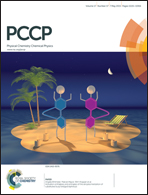Molybdenum disulfide as a highly efficient adsorbent for non-polar gases†
Abstract
Molybdenum disulfide (MoS2), a kind of graphene-like, two-dimensional material, has attracted great interest because of its unique properties and potential applications in electronics and sensors. In this paper, first-principle calculations and grand canonical Monte Carlo (GCMC) simulations are performed and used to show that the MoS2 layer is efficient at absorbing non-polar gases. Compared with the popular gas sorbents (metal organic frameworks and carbon-based materials), MoS2 has additional advantages, including large surface to volume ratio and tunable properties. The non-polar gas [carbon dioxide (CO2) and methane (CH4)] adsorption on the MoS2 layer with and without vacancies has been systematically studied. The perfect MoS2 shows little or no adsorption for CO2 and CH4 molecules, but the MoS2 with a single S vacancy and double S vacancies exhibits an excellent adsorption ability for CO2 and CH4 gases. The adsorption energies were 65 kJ mol−1 for CO2 and 47 kJ mol−1 for CH4 (van der Waals-D2), respectively. An orbital coupling between the p orbital of the CO2 (or CH4) molecule and the d orbital of the Mo atom was observed. GCMC simulation results show that MoS2 with a single S vacancy could absorb 42.1 wt% of CO2 and 37.6 wt% of CH4 under a pressure of 80 bar at room temperature. The results given in this paper indicate that monolayer MoS2 with defects is a highly efficient absorbent for non-polar gases.


 Please wait while we load your content...
Please wait while we load your content...